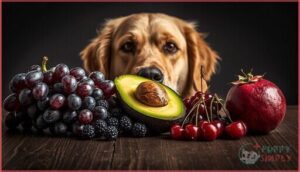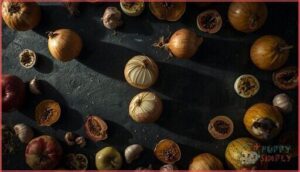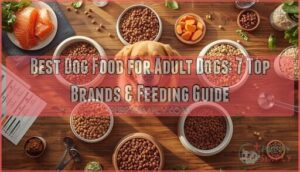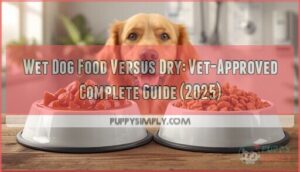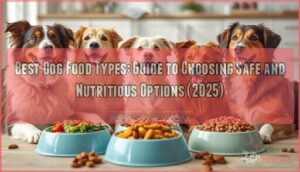This site is supported by our readers. We may earn a commission, at no cost to you, if you purchase through links.
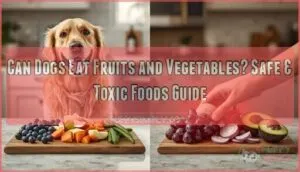
Your dog’s digestive system processes plant matter differently than yours does, which means that seemingly innocent snacks like grapes or onions can cause kidney failure or toxicity. Understanding which fruits and vegetables belong in your dog’s bowl—and which ones should never come near it—protects your pet while expanding their nutritional options beyond standard kibble.
Table Of Contents
- Key Takeaways
- Can Dogs Eat Fruits and Vegetables?
- Safe Fruits for Dogs
- Vegetables Safe for Dogs
- Fruits and Vegetables Dogs Should Avoid
- How to Safely Feed Fruits and Vegetables
- Frequently Asked Questions (FAQs)
- Should I wash fruits and vegetables before feeding them to my dog?
- How much fruit should I give my dog per day?
- If my dog has allergies or intolerances, what produce should I avoid?
- Are there any benefits to giving my senior dog fruits and vegetables?
- Can puppies eat the same fruits as adult dogs?
- Are organic fruits safer for dogs than conventional?
- Do certain dog breeds have different fruit tolerances?
- Can fruits help with my dogs bad breath?
- Conclusion
Key Takeaways
- Dogs can safely eat certain fruits and vegetables like apples, blueberries, carrots, and green beans, which provide valuable vitamins, fiber, and antioxidants, but these treats should never exceed 10% of their daily caloric intake to prevent digestive issues and nutritional imbalances.
- Toxic fruits and vegetables including grapes, raisins, onions, avocados, and cherry pits can cause severe health complications ranging from kidney failure to anemia, requiring immediate veterinary care if ingestion occurs.
- Proper preparation is critical—always remove seeds, pits, cores, and rinds before feeding, wash all produce thoroughly to eliminate pesticide residues, and cut everything into bite-sized pieces appropriate for your dog’s size to prevent choking hazards.
- Introduce new fruits and vegetables gradually over 7-10 days while monitoring for allergic reactions or digestive upset, and consult your veterinarian before making dietary changes for dogs with existing health conditions like diabetes or kidney disease.
Can Dogs Eat Fruits and Vegetables?
Yes, dogs can eat certain fruits and vegetables as part of a balanced diet. These foods offer valuable vitamins, fiber, and antioxidants that complement your dog’s nutritional needs.
However, understanding which options are safe and how to serve them properly makes all the difference in keeping your pet healthy.
Nutritional Benefits for Dogs
Fruits and vegetables offer significant nutritional benefits for your dog, providing essential vitamins, minerals, and fiber that support healthy digestion and overall wellness. Antioxidants like vitamins C and E strengthen immune support, while fiber intake promotes gut health and weight management.
These foods improve nutrient balance, delivering potassium for muscle function and beta-carotene for vision. The antioxidant role in dog nutrition helps combat cellular damage, making these natural additions valuable components of a complete diet.
A balanced diet should include fresh food options to guarantee peak health.
Importance of Moderation
While fruits and vegetables provide valuable nutrients, moderation remains paramount to your dog’s health. Treats—including produce—shouldn’t exceed 10% of daily caloric intake to maintain balanced diets and proper nutrient control. Exceeding healthy treat limits can lead to digestive upset, weight gain, or blood sugar spikes, particularly with high-sugar options.
Following safe dog dietary guidelines through portion management ensures these additions improve rather than compromise your pet’s nutrition. Understanding phytonutrient benefits is vital for making informed decisions about your dog’s diet.
General Dietary Guidelines
Beyond moderation, your dog’s overall dietary balance matters most. Commercial dog foods typically meet complete nutrient needs, so fruits and vegetables serve as supplementary healthy snacking options rather than meal replacements.
When meal planning, guarantee these additions stay within the 10% caloric intake threshold—this dog dietary guidelines framework prevents nutritional imbalances while letting you explore safe fruits for dogs.
Proper canine nutrition bolsters your dog’s health and diet without compromising their essential requirements.
Safe Fruits for Dogs
Many fruits make healthy, nutritious treats for your dog when served properly. These natural snacks provide vitamins, fiber, and antioxidants that can complement your pet’s regular diet.
Here are some safe fruit options you can confidently share with your canine companion.
Apples (Preparation and Benefits)
Apples rank among the safest fruits for dogs, offering a crisp way to boost hydration and support dog digestion with their fiber-rich profile. These crunchy treats deliver vitamin C and antioxidants that improve canine wellness while keeping calories low.
Before serving, you’ll want to remove the core and seeds completely, then slice the apple into bite-sized pieces that match your dog’s size—turning fruit as dog treats into both safe and nutritious rewards.
Bananas (Serving Size and Cautions)
Bananas bring potassium and fiber to your dog’s diet, but their high sugar content demands careful portion control. Extra-small dogs should receive only 1–2 thin slices, while large breeds can enjoy up to half a banana daily—keeping fruit serving size for dogs within that critical 10% treat threshold.
Dogs with obesity or diabetes need fruit allergies and sensitivities monitored closely, as excessive banana nutrition may trigger pet digestion issues or weight gain.
Blueberries, Cantaloupe, and Watermelon
Three powerhouse choices stand out for canine hydration and dog wellness: blueberries, cantaloupe, and watermelon. These safe fruits and vegetables for dogs deliver antioxidant benefits through vitamin C, vitamin K, and lycopene while supporting healthy snacking habits.
Fruit nutrition highlights:
- Blueberries provide 36% daily vitamin K per cup, slowing brain aging
- Cantaloupe’s 90% water content aids digestion and hydration
- Watermelon offers fat-free, low-calorie refreshment
- Always remove seeds and rinds to prevent choking
- Limit portions to avoid fruit toxicity in dogs from excess sugar
Pears and Oranges
You can add pears to your dog’s rotation—they pack 5.5 grams of fiber per fruit and support canine digestion with vitamin C and potassium. Just remove seeds and cores, as they contain compounds that pose fruit toxicity in dogs.
Oranges offer similar orange benefits for pet wellness, but their citric acid may upset sensitive stomachs. Skip the peel, limit portions to one slice, and watch for fruit allergies before expanding these safe fruits and vegetables for dogs into your routine.
Preparation Tips and Serving Suggestions
Proper fruit washing removes up to 80% of pesticide residues, so rinse every apple or blueberry under cool water before you slice. For preparing fruit for dogs, cut into bite-sized pieces and remove all seeds, pits, and rinds.
Vegetable steaming retains nutrients while improving digestibility—light blanching works perfectly for carrots and green beans, preserving vitamin content for ideal dog health and nutrition.
Vegetables Safe for Dogs
Vegetables can be a nutritious addition to your dog’s meals, offering vitamins and fiber without the higher sugar content found in many fruits. However, not all vegetables are created equal regarding canine health.
Let’s look at which vegetables you can safely share with your dog and how each one benefits their diet.
Carrots (Raw, Cooked, and Frozen)
Carrots stand out as one of the safest vegetables for dogs, offering excellent carrot nutrition whether you serve them raw, cooked, or frozen. Rich in vitamins A, C, and K, these dog-friendly treats fit perfectly within dog health and nutrition guidelines.
You’ll find they’re packed with fiber content that aids digestive health, while their crunchy texture provides dental benefits by naturally scraping away plaque.
Though rare, monitor for carrot allergy symptoms when introducing them.
Green Beans and Peas
Green beans and peas rank among the safest vegetables for dogs, offering impressive green bean nutrition and pea benefits that support canine digestion.
You can feed green beans fresh, frozen, or lightly steamed—one cup delivers just 31 calories with 2.7 grams of fiber content, making them ideal healthy dog treats.
Peas provide protein and B vitamins, though moderation matters for healthy snacking that meets dog dietary needs.
Sweet Potatoes and Broccoli
Sweet potatoes deliver outstanding sweet potato nutrition—14,000 IU of vitamin A per 100 grams bolsters your dog’s vision and immune system, while 3 grams of fiber aids canine digestion. Always serve them cooked; raw tubers risk intestinal blockages.
Broccoli benefits include sulforaphane for cellular health, but limit portions to prevent gastric irritation.
Both vegetables promote nutrient balance and healthy snacking when properly prepared for safe food enjoyment.
Celery and Cabbage
Celery and cabbage both support dog digestion through impressive celery nutrition—7 calories per stalk, loaded with fiber and antioxidants. Cabbage benefits include vitamin K for bone health and gut-friendly compounds that aid healthy snacking.
Chop both into bite-sized pieces to guarantee dog food safety and prevent choking. Watch for vegetable allergies or gas, and avoid daily servings to protect thyroid function—these safe vegetables for dogs shine in moderation.
Recommended Quantities and Benefits
While celery and cabbage work well occasionally, your overall approach to safe vegetables for dogs matters more.
Keep fruits and vegetables under 10% of daily calories—that’s roughly 40–70 grams for medium breeds. This caloric contribution ensures proper vitamin intake and fiber content without disrupting dog nutrition.
Antioxidant-rich produce reduces oxidative stress by up to 30%, improves hydration effects, and strengthens dog health when you stay within these boundaries.
Fruits and Vegetables Dogs Should Avoid
While many fruits and vegetables are safe for your dog, some can be downright dangerous. Certain foods contain compounds that are toxic to dogs, even in small amounts, and can lead to serious health problems or even kidney failure.
Let’s look at which fruits and vegetables you need to keep off your dog’s plate entirely.
Toxic Fruits (Grapes, Raisins, Avocado, Cherries, Currants, Starfruit)
Some fruits pose serious threats to your dog’s health and should never be offered. Grape toxicity and raisin poisoning can trigger kidney failure at doses as low as 0.7 ounces per kilogram. Currant dangers mirror grape toxicity, and starfruit effects include acute kidney damage from oxalates.
Grapes, raisins, currants, and starfruit are toxic to dogs and can cause kidney failure even in small amounts
Avocado risks include gastrointestinal upset from persin, while cherry poisoning occurs when pits release cyanide.
Unsafe Vegetables and Parts (Onions, Pits, Seeds, Rinds)
Beyond fruit-based threats, certain vegetables and plant parts demand your vigilance. Onion toxicity occurs at doses as low as 5 grams per kilogram, damaging red blood cells and causing anemia. Cyanide exposure from pits and seeds—particularly apple cores and stone fruit pits—requires immediate seed removal before feeding.
- Pit obstruction risks increase in small to medium breeds
- Rind dangers include digestive blockages from watermelon and citrus
- Toxic vegetables for dogs encompass onions, garlic, and leeks
- Poisonous foods often hide in seemingly safe produce parts
Symptoms of Toxicity and Emergency Actions
When your dog shows vomiting, diarrhea, or lethargy within hours of eating suspect foods, you’re witnessing toxicity symptoms that demand immediate emergency veterinary care. Neurological signs like seizures or tremors signal severe poisoning from specific toxins like cyanide or oxalates, while kidney injury from grapes develops within 24-72 hours.
| Symptom Category | Warning Signs |
|---|---|
| Gastrointestinal | Vomiting, diarrhea, abdominal pain |
| Neurological Signs | Tremors, seizures, weakness |
| Kidney Injury | Lethargy, bloody urine, collapse |
Emergency protocols include inducing vomiting within 1-2 hours and administering IV fluids to flush toxins and support renal function.
How to Safely Feed Fruits and Vegetables
Knowing which fruits and vegetables are safe is only half the equation. How you prepare and serve them matters just as much as what you choose.
Let’s walk through the practical steps to make sure your dog gets the most benefit without any unnecessary risk.
Proper Preparation and Serving Size
Preparing your dog’s produce correctly prevents choking hazards and digestive issues. Always remove seeds, pits, and rinds—these contain toxic compounds and cause gastrointestinal upset. Use proper cutting techniques: slice fruits and vegetables into bite-sized pieces appropriate for your dog’s size.
Cooking methods matter too—steam or bake starchy vegetables like sweet potatoes until soft. Remember, dog treats shouldn’t exceed 10% of daily calories, so practice portion control when supplementing their regular dog food.
Introducing New Foods and Monitoring Reactions
Think of your dog’s digestive system like a finely tuned instrument—sudden changes throw everything off balance. Gradual introduction over 7–10 days prevents digestive issues, starting with 25% new food mixed with their regular diet.
Monitor stool quality daily and watch for allergy symptoms like vomiting or skin irritation. If adverse reactions persist beyond two weeks, veterinary consultation ensures your dog’s health stays on track.
Risks of Overconsumption
Even healthy treats can backfire when portions spin out of control—overconsumption transforms nutritious fruits and vegetables into digestive disruption and metabolic issues. Excessive sugar content from fruits or fiber content from vegetables overwhelms your dog’s digestive system, triggering serious health consequences.
- Gastrointestinal distress: Vomiting and diarrhea appear in 43–68% of overconsumption cases
- Nutritional imbalances: 40% of homemade diets fall outside veterinary guidelines
- Obesity risks: Excess calories increase body weight considerably within 6–12 months
- Toxicity signs: Symptoms occur in 7.5% of emergency cases involving inappropriate produce
- Kidney failure: Grapes cause acute renal damage at just 32 grams per kilogram bodyweight
When to Consult a Veterinarian
Toxic ingestion demands immediate action—contact your veterinarian if you notice persistent symptoms like vomiting beyond 12 hours or diarrhea lasting over 24 hours after introducing new foods. Severe reactions including difficulty breathing, facial swelling, or seizures require emergency veterinary care.
Before making dietary changes for dogs with diabetes or kidney disease, professional guidance protects your pet’s health and prevents complications from toxic fruits or allergic reactions.
Frequently Asked Questions (FAQs)
Should I wash fruits and vegetables before feeding them to my dog?
Always absolutely wash fruits and vegetables for dogs before feeding. Bacterial contamination and pesticide exposure pose serious health risks—even organic options require rinsing. This simple step safeguards your dog’s health effectively.
How much fruit should I give my dog per day?
You should keep fruit treats under 10% of your dog’s daily caloric intake. For most dogs, this means a few small pieces per day, adjusted for their size and activity level.
If my dog has allergies or intolerances, what produce should I avoid?
If your dog has allergies, avoid cross-reactive produce like apples or carrots, oxalate-rich foods such as spinach, and fruits containing persin toxicity.
Monitor for allergic reactions when introducing any new fruits and vegetables for dogs.
Are there any benefits to giving my senior dog fruits and vegetables?
Your senior dog’s golden years can truly shine with the right nutritional boost. Fruits and vegetables offer antioxidant support, cognitive function improvements, joint health benefits, and weight management—all while promoting digestive health through fiber-rich, age-appropriate choices.
Can puppies eat the same fruits as adult dogs?
Yes, puppies can eat the same safe fruits as adult dogs, but portion size matters greatly due to their smaller bodies and developing digestive systems.
Always avoid toxic fruits and consult your veterinarian before introducing new foods into your puppy’s canine diet.
Are organic fruits safer for dogs than conventional?
Organic fruits contain fewer pesticide residues than conventional options, reducing your dog’s pesticide exposure. However, nutrient variation between them is minimal, and both carry similar microbial risks and heavy metals—thorough washing matters most.
Do certain dog breeds have different fruit tolerances?
Breed sensitivities do influence fruit tolerances. Genetic predispositions and digestive physiology vary—Boxers and German Shepherds show heightened allergic reactions, while diabetic-prone breeds need careful sugar moderation. Your veterinarian can guide breed-specific canine diet adjustments.
Can fruits help with my dogs bad breath?
While fruits won’t fix serious dental health issues, enzymatic action from papaya and mechanical cleaning from crunchy apples can reduce plaque by up to 50%, freshening breath when combined with veterinarian advice.
Conclusion
Think of your dog’s bowl as a canvas—each safe fruit and vegetable adds a brushstroke of nutrition, but one toxic choice can ruin the entire picture. Preparation matters, moderation protects, and when uncertainty strikes, your veterinarian remains your most reliable guide for species-appropriate nutrition.
Now that you know which fresh foods improve your pet’s health and which ones threaten it, you can confidently answer “can dogs eat fruits and vegetables” with informed choices.
- https://onlinelibrary.wiley.com/doi/10.1111/jpn.13626
- https://www.frontiersin.org/journals/veterinary-science/articles/10.3389/fvets.2022.898056/full
- https://www.sciencedirect.com/science/article/pii/S0034528822001345
- https://www.bonza.dog/2025/07/oxidative-damage-in-dogs-unhealthy-impacts-on-health
- https://www.feedreal.com/articles/fruits-and-veggies-can-be-beneficial



